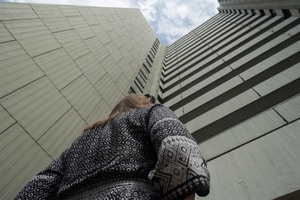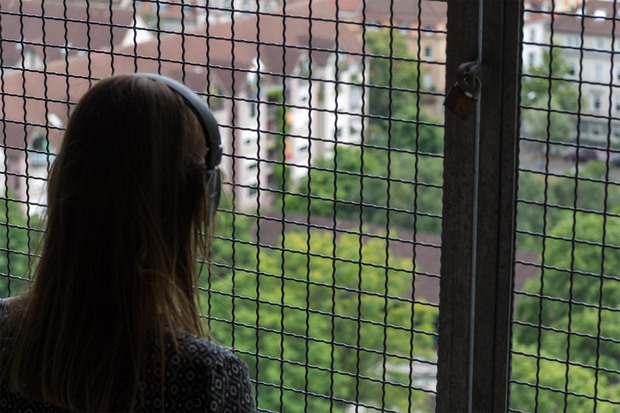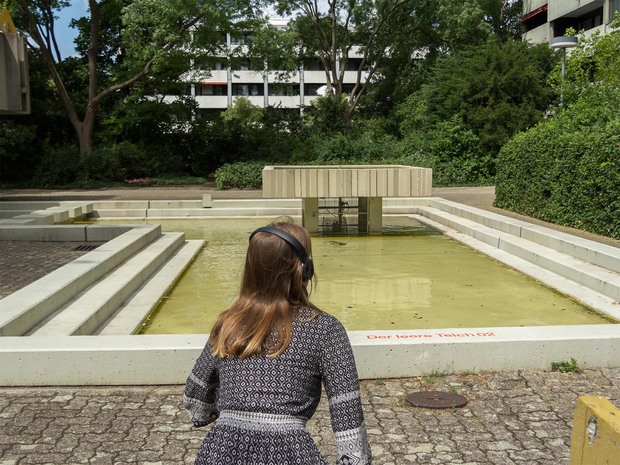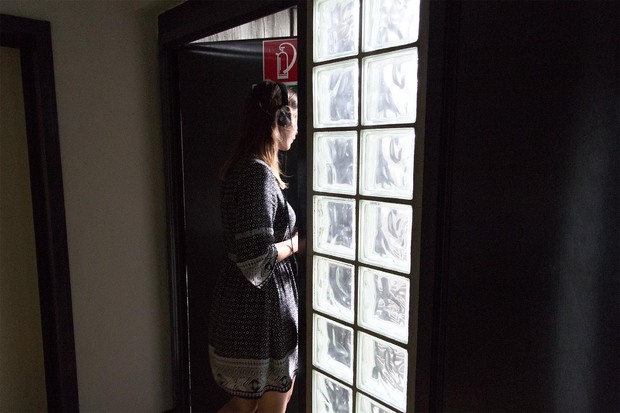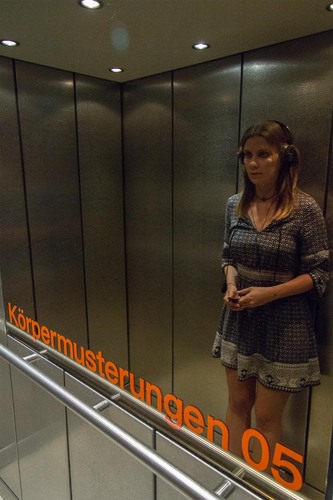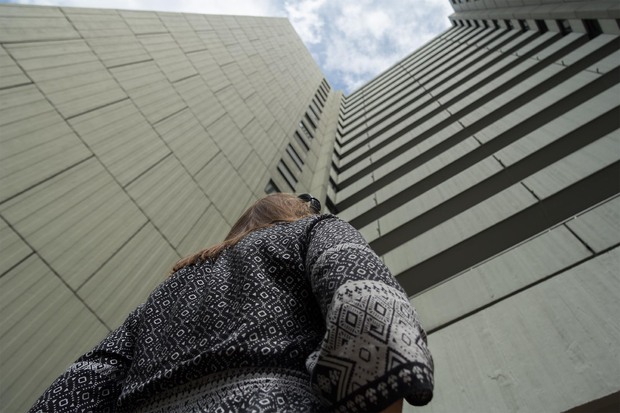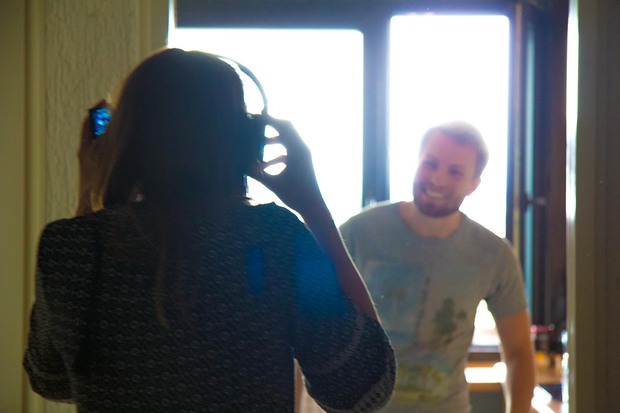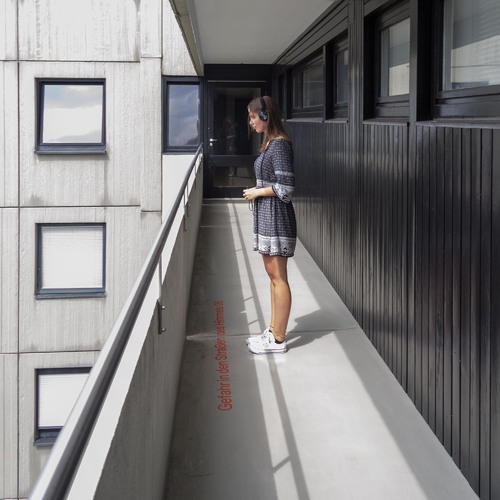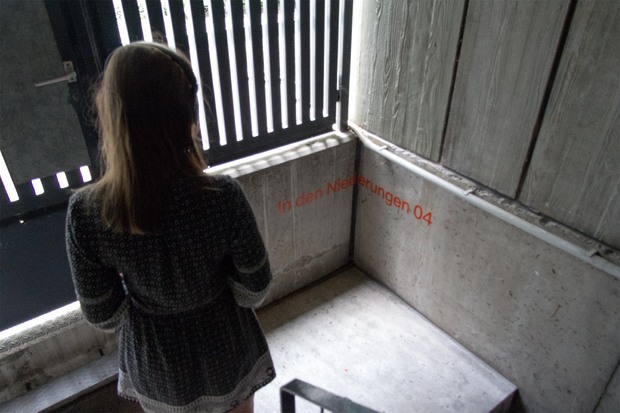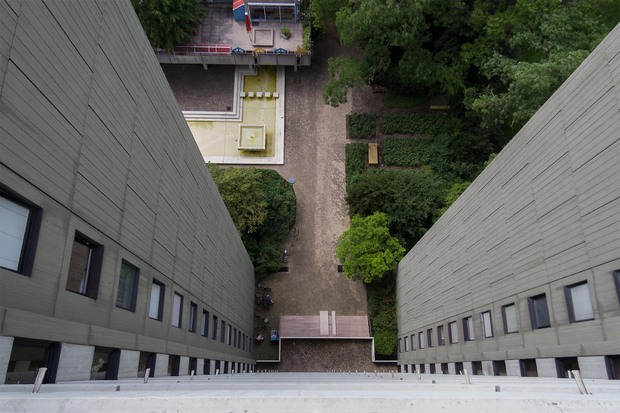| Titel | |
| Autor/in | |
| Kategorie | |
| Schlagworte | |
| Betreuer/innen | |
| Semester | |
| Studiengang | |
| Typ der Abschlussarbeit | |
| Beschreibung | - Der HOCHHAUS Audiowalk führt die Teilnehmer*innen an spezifische Orte des Hochhauses der Kaiserallee 15 in Karlsruhe und lässt das Gebäude zum Hauptakteur werden. In neun Audiotracks werden collageartig Texte aus verschiedenen Perspektiven verarbeitet.
|
| Beschreibung (en) | - The HOCHHAUS audio walk takes participants to specific locations in the high-rise building at Kaiserallee 15 in Karlsruhe, making the building the main protagonist. In nine audio tracks, texts from different perspectives are collaged together.
|
| Ausführliche Beschreibung | - Die selbst in betreffendem Hochhaus lebende Künstlerin kombiniert sowohl ihre eigenen Beobachtungen innerhalb des Hochhausterrains als auch die von anderen Bewohner*innen mit Zitaten aus einer historischen Werbebroschüre für den Wohnkomplex, mit Originaltönen aus einem Interview mit dem Hausmeister, der sich schon seit der Fertigstellung um das Gebäude kümmert, und mit Auszügen aus J.G. Ballards Roman Hochhaus aus dem Jahre 1975. Die Tracks sind mit ausgewählten Kapitelüberschriften aus dem Roman betitelt. Sie leiten die Erzählung und bezeichnen die Orte, an die die Audiowalkteilnehmer*innen von einer Erzählstimme mit verbalen Anweisungen geführt werden. Durch die Mischung von fiktionalem, dokumentarischem und originär geschaffenem Material entstehen vier Text- sowie verschiedene Zeitebenen: Die des Hochhausbaus, jene des Romans und die Ebene der Gegenwart. Sie verflechten sich zunehmend, wobei der Hausmeister als (reale) Figur und Interviewpartner zwischen diesen Zeiten steht und als Bindeglied funktioniert. Das Gehörte wird durch die visuelle Wahrnehmung der Audiowalkteilnehmer*innen, die alleine dem Aufstieg eines Protagonisten aus dem Roman in die oberen Etagen des Betonriesen folgen, ergänzt. Abgespielt wird der Audiotext über einen handlichen MP3-Player und Kopfhörer.
Der Romantext stammt aus der Zeit des Betonhochhausbooms der siebziger Jahre. Das ist auch die Zeit, in der der Hausmeister der Kaiseralle 15 eine neue Arbeit fand und aus dem Einfamilienhaus in Bayern in das Hochhaus zog, das er nie mehr verlassen sollte. Aus dem Roman entnommen sind bestimmte Figuren, spezifische Hochhausbewohner, die die Teilnehmer*innen auf ihrem Weg durch das Gebäude begleiten und deren Rolle sie immer wieder durch ihre physische Präsenz am Ort einnehmen können. Dem gegenübergestellt sind die Berichte des Hausmeisters und die Beobachtungstexte. Die von Ballard erdachte Extreme, in der das Hochhausleben in völliger Abschottung im Chaos anarchistischer Zustände endet, überlagern sich mit den Aussagen des Hausmeisters. Die Interviewaussagen in Verbindung mit den anderen Textebenen schaffen einerseits Diskrepanzen, andererseits aber auch eine Verbindung zwischen Fiktion und Realität. Das akustische Konzept umfasst nicht nur die gesprochenen und gelesenen Texte sowie die Atmo-Aufnahmen aus dem Haus und seiner Umgebung. Auch musikalische Einschübe unterstützen das Klangkonzept. Vollständig realisiert dieses sich aber erst in der Durchmischung der Klänge aus dem Kopfhörer mit den real vor Ort präsenten akustischen Ereignissen. Die Teilnehmer*innen erleben es in Verbindung mit ihren eigenen Handlungen und den vielfältigen Sinneseindrücken aus ihrer körperlichen Präsenz.
Die Texte funktionieren ortsspezifisch, ob im Untergeschoss beim Notausgang, wo das Draußen nur durch eine Gittertür abgehalten wird, im außenliegenden Treppenhaus des Gebäudes, das den Tauben als Zuhause dient, oder am Brunnen im Innenhof. Der Audiotext gibt die Handlungen und den Weg vor. Die Titel der Tracks sind als Schriftzüge sichtbar an den Orten angebracht und geben das Signal zum Weiterschalten der Tracks. Zudem erweitern sie das auditive Element an den visuellen Ort. Sie greifen von außen in den bestehenden Raum, beschreiben den Ort, verändern ihn und transportieren das Erzählte aus der Buchvorlage in die reale Umgebung in Form von Schrift. Die sichtbaren Titel gehen einerseits mit dem Gehörten, andererseits in Zusammenhang mit der Umgebung eine Symbiose ein.
Die Haltung der Teilnehmer*innen ist partizipativ. Sie folgen den Anweisungen des Audiowalks und werden dadurch direkt in die Texte miteinbezogen. Die in den Text eingeflossenen Beobachtungen mischen sich mit den Beobachtungen der Teilnehmer*innen während des Walks, sie überlagern sich und werden so zu einer individuellen Erfahrung der Partizipierenden. Auch die Bewohner*innen sind Akteure, die den Teilnehmer*innen auf ihrem Weg begegnen oder die sie beobachten. Die spezifische Ortswahl und die Texte, wonach die Teile des Audiowalks zu einem Erzählstrang entwickelt wurden, schränken die Teilnehmer*innen in ihrer Freiheit am Ort ein, sofern sie sich den akustischen Anweisungen nicht aktiv widersetzen. Sie können immer nur so weit vordringen, wie es die Stimme erlaubt und sind somit dem Tempo und Rhythmus der Geschichte unterworfen, denen die allmähliche Entwicklung in Ballards Roman zu Grunde liegt. Der Raum und die Erzählung werden so Schritt für Schritt eröffnet. Betritt man den von der Straße entfernten innen liegenden Hof, findet man sich offiziell auf einem Privatgelände wieder. Die Audiowalkteilnehmer*innen überschreiten diese Schwelle und finden Orte zwischen Außen und Innen, zwischen öffentlich und privat.
Sicherlich ist das Hochhaus der Kaiserallee 15 keine Wohnmaschine im Sinne Le Corbusiers, das alle Versorgungseinrichtungen im Gebäude integriert sieht und auf dessen Konzept sich Ballard beziehen mag. Das Bauprojekt Kaiserallee konzentrierte sich nicht auf eine vollständige Autarkie, sondern auf das Leben in der näheren Umgebung und fungiert als gewöhnliches Wohngebäude für unterschiedliche Menschen. Als Hochhaus ist der Wohnkomplex dennoch einer bestimmten Konnotation ausgesetzt. Viele Menschen auf engem Raum, Abschottung, die Anonymität, Einsamkeit und vielleicht auch die Gefahr, die davon ausgehen könnte, finden Einzug in ein allgemeines Verständnis über das Leben in einem solchen Komplex. Die thematisierten Probleme in Ballards Szenario spiegeln sich teilweise in der Realität des Hochhauslebens der Kaiserallee 15 wider, wie beispielsweise entstandene Brände, ausgefallene Technik oder einzelne Bewohner*innen, die Müll über die Balkons entsorgen. In der Gegenüberstellung dieser Parallelitäten zum Roman mit kleineren beiläufigen Beobachtungen aus der Gegenwart über die Einfachheit und Genügsamkeit des Lebens in der Kaiserallee 15, beispielsweise der Ingangsetzung des Brunnens für den Frühling, wird das Hochhaus im Audiowalk auch in seiner Alltäglichkeit thematisiert. Eher kleinere Dramen als große Zusammenbrüche stehen an der Tagesordnung. Zurückgeholt auf diese Ebene werden die Teilnehmer*innen am Ende des Walks durch das Eintreten in eine Wohnung im 17. OG. des Hochhauses und das Treffen auf deren Bewohner. Man verabschiedet sich von der fiktiven Geschichte, indem man die Kopfhörer ablegt und ins Gespräch kommt. Die Möglichkeit der direkten Konversation mit den Bewohnern gibt den Teilnehmer*innen die Gelegenheit, Erfahrungen auszutauschen sowie Fragen zu stellen und ihnen wird ein Einblick in einen der privatesten Orte im Haus gewährt.
Die Verbindung aller zugespielten und vor Ort erlebten Elemente, die sinnliche Wahrnehmung einzelner Stationen und des Ortes als Ganzes, setzen das Gefüge aus Collagetexten und der Partizipation der Teilnehmer*innen als Akteure, zusammen. Die besuchten Orte verschmelzen mit dem Text zu einer Spielfläche dokumentarischer und fiktiver Erzählung. Auf Basis von Narration und multisensorischen Erfahrungen wird die Vielschichtigkeit des Hochhauses in einer neuen Weise erfahrbar.
Tracks:
01 Eine Wegstrecke
02 Der leere Teich
03 Ein glückliches Arrangement
04 In den Niederungen
05 Körpermusterungen
06 Vorbereitungen für den Auszug
07 Die Raubvögel
08 Gefahr in den Straßen des Himmels
09 Letzter Triumph
|
| Ausführliche Beschreibung (en) | - The artist, who herself lives in the high-rise building in question, combines her own observations within the high-rise terrain as well as those of other residents with quotes from a historical advertising brochure for the residential complex, with original sounds from an interview with the janitor, who has been looking after the building since its completion, and with excerpts from J.G. Ballard's 1975 novel Hochhaus. The tracks are titled with selected chapter headings from the novel. They guide the narrative and designate the locations to which the audio walk participants are led by a narrative voice with verbal instructions. The mixture of fictional, documentary and original material creates four levels of text and time: That of the skyscraper construction, that of the novel and the level of the present. They become increasingly intertwined, with the janitor as a (real) figure and interviewee standing between these times and functioning as a link. What is heard is supplemented by the visual perception of the audio walk participants, who alone follow the ascent of a protagonist from the novel to the upper floors of the concrete giant. The audio text is played via a handy MP3 player and headphones.
The text of the novel dates back to the concrete high-rise boom of the 1970s. This is also the time when the janitor of Kaiseralle 15 found a new job and moved from his detached house in Bavaria to the high-rise that he was never to leave. Certain characters are taken from the novel, specific high-rise residents who accompany the participants on their way through the building and whose role they can take on again and again through their physical presence in the place. This is contrasted with the janitor's reports and the observation texts. The extremes imagined by Ballard, in which high-rise life ends in complete isolation in the chaos of anarchistic conditions, overlap with the janitor's statements. The interview statements in conjunction with the other text levels create discrepancies on the one hand, but also a connection between fiction and reality on the other. The acoustic concept includes not only the spoken and read texts as well as the atmospheric recordings from the house and its surroundings. Musical inserts also support the sound concept. However, this is only fully realized when the sounds from the headphones are mixed with the acoustic events actually present on site. The participants experience it in connection with their own actions and the diverse sensory impressions from their physical presence.
The texts work site-specifically, whether in the basement by the emergency exit, where the outside is only kept out by a barred door, in the outside stairwell of the building, which serves as a home for the pigeons, or by the fountain in the inner courtyard. The audio text provides the action and the route. The titles of the tracks are visibly attached to the locations as lettering and provide the signal to switch to the next track. They also extend the auditory element to the visual location. They reach into the existing space from the outside, describe the location, change it and transport the narrative from the original book into the real environment in the form of writing. The visible titles enter into a symbiosis with what is heard on the one hand and with the surroundings on the other.
The attitude of the participants is participatory. They follow the instructions of the audio walk and are thus directly involved in the texts. The observations included in the text are mixed with the observations of the participants during the walk, they overlap and thus become an individual experience of the participants. The residents are also actors who meet the participants on their way or who observe them. The specific choice of location and the texts, according to which the parts of the audio walk were developed into a narrative thread, restrict the participants' freedom in the location, provided they do not actively resist the acoustic instructions. They can only advance as far as the voice allows and are thus subject to the pace and rhythm of the story, which underlies the gradual development in Ballard's novel. The space and the narrative are thus opened up step by step. When you enter the courtyard, which is located away from the street, you officially find yourself on private property. The audio walk participants cross this threshold and find places between outside and inside, between public and private.
Certainly, the high-rise building at Kaiserallee 15 is not a living machine in the sense of Le Corbusier, who saw all utilities integrated into the building and to whose concept Ballard may be referring. The Kaiserallee building project did not focus on complete self-sufficiency, but on life in the immediate vicinity and functions as an ordinary residential building for different people. As a high-rise building, the residential complex nevertheless has a certain connotation. Many people in a confined space, isolation, anonymity, loneliness and perhaps also the danger that could emanate from it find their way into a general understanding of life in such a complex. The problems addressed in Ballard's scenario are partly reflected in the reality of high-rise life at Kaiserallee 15, such as fires, broken-down technology or individual residents disposing of garbage on the balconies. By juxtaposing these parallels to the novel with smaller, incidental observations from the present about the simplicity and frugality of life in Kaiserallee 15, such as the starting of the fountain for spring, the high-rise building is also thematized in its everyday life in the audio walk. Minor dramas rather than major breakdowns are the order of the day. The participants are brought back to this level at the end of the walk by entering an apartment on the 17th floor of the high-rise building and meeting its residents. You say goodbye to the fictional story by taking off your headphones and engaging in conversation. The possibility of direct conversation with the residents gives the participants the opportunity to exchange experiences and ask questions and gives them an insight into one of the most private places in the building.
The combination of all the elements played and experienced on site, the sensory perception of individual stations and the place as a whole, make up the structure of collage texts and the participation of the participants as actors. The places visited merge with the text to form a playing field of documentary and fictional narratives. On the basis of narration and multi-sensory experiences, the complexity of the high-rise building can be experienced in a new way.
Tracks:
01 A route
02 The empty pond
03 A happy arrangement
04 In the lowlands
05 Body patterns
06 Preparations for departure
07 The birds of prey
08 Danger in the streets of the sky
09 Last triumph
|
| Mitwirkende / weitere Personen | |
| Dauer | |
